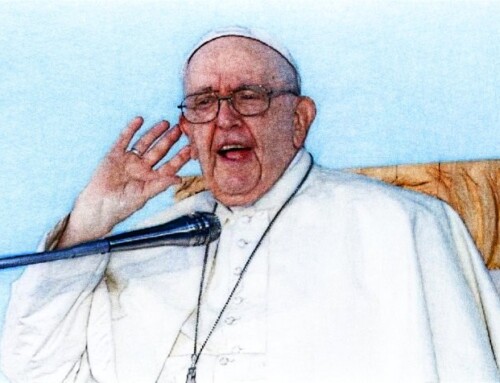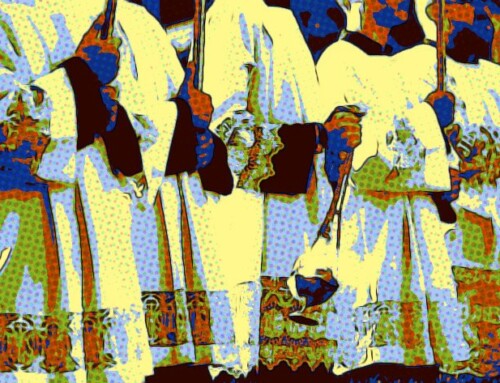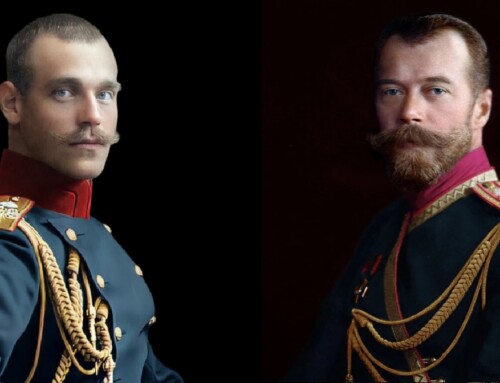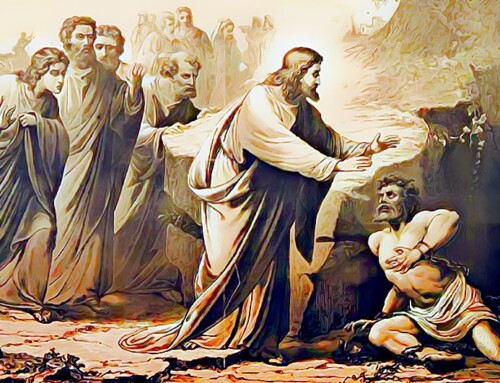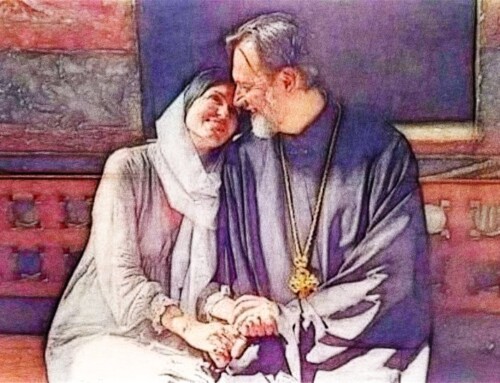Be careful around those who are rigid. Be careful around Christians – be they laity, priests, bishops – who present themselves as so “perfect,” rigid. Be careful. There’s no Spirit of God there. – Pope Francis
I was born into a turbulent time. In 1968, with the publication of “Humanae Vitae,” the condemnation of artificial birth control by Pope Paul VI sparked an open rebellion in the Catholic Church. He prophetically warned that the separation of sex from procreation in the martial union would result in a proliferation of sexual immorality. In 1969, Paul VI promulgated the “New Roman Missal” or the Novos Ordo. Later that same year, the Stonewall Riots launched the LGBT rights movement.
50 years later, there is controversy swirling around the apostolic exhortation “Amoris Laetitia;” a sex abuse scandal has engulfed the Church; and the summation of gay liberation has been reached with the legalization of same-sex marriage in the United States and much of the West.
During the intervening years, for the most part, the state of LGBT ministry within the Catholic Church has been inconsistent at best. Associated with the establishment of these ministries were the rise of the unapologetically pro-gay social justice warrior priest; in particular: Daniel Berrigan, Charles Curran, and John J. McNeill; and, beginning in the early 1970s, Fr. Robert Nugent and Sister Jeannine Gramick began their LGBT-affirmative ministry that eventually became New Ways Ministry.
Charles Curran, in his 1972 book “Catholic Moral Theology in Dialogue,” wrote:
Celibacy and sublimation are not always possible or even desirable for the homosexual. There are many somewhat stable homosexual unions which afford their partners some human fulfillment and contentment. Obviously, such unions are better than homosexual promiscuity…the individual homosexual may morally come to the conclusion that a somewhat permanent homosexual union is the best, and sometimes the only, way for him to achieve some humanity.
John J. McNeill argued that homosexuals could outright reject Church teaching:
Since most gay people experience their homosexual orientation as a part of creation, if they accept this Church teaching, they must see God as sadistically creating them with an intrinsic orientation to evil. Most gays would prefer to see the Church teaching as wrong, rather than believe God is sadistic.
By 1992, in a book she co-authored with Robert Nugent, Jeannine Gramick dispelled altogether with the necessity of the Church:
A lesbian/gay spirituality or theology begins with the individual’s encounter with God. It is not necessary that God’s presence be mediated through formal religious structures…In their personal encounter with the living God, lesbian and gay people must read the scriptures in the light of their own experience…In his ministry of teaching and healing, Jesus challenged the authority of the religious leaders of his day. By the witness of their lives of faith, responsibility, and love, lesbian and gay Christians similarly reject traditional teachings regarding the moral status of homogenital acts and thus threaten the authority of contemporary religious structures.
When I was a boy, on the somewhat rare occasion that the entire school went to Mass, for several days prior, accompanied by their guitar playing, the nuns taught us Simon & Garfunkel songs that they deemed proper liturgical music. Sometimes, instead of a Gospel reading, a passage from Jonathan Livingston Seagull by Richard Bach served as a worthy substitute. I remember: “that whatever stands against…freedom must be set aside, be it ritual or superstition or limitation in any form.” He added, “The only law is one which leads to freedom…”
The liturgy seemed to vary with the times and remained completely inconsistent and wavering: Communion is only received on the tongue – a year later, in the palm of the hand is permissible; only the priest can distribute Communion – that practice changed to include certain lay men and women as Eucharistic ministers; only boys may serve as altar servers – within a few years, girls and women were the dominant presence in the sacristy.
The primacy of the conscience was the only thing I truly remembered from 12 years of “religion” classes. After that it wasn’t difficult to accept Aleister Crowley’s mantra “Do what thou wilt shall be the whole of the law.” I was told that everything in Catholic teaching, even with regards to abortion, on the individual level, was completely subjective. Therefore, by the time I reached my mid-teens, I had already reconciled with my conscience about my own homosexuality. A priest urged me along by telling me that: “God made me this way.” According to him, I could find happiness – with another man. Although I instinctively knew that this was not the way the world typically worked, I believed that I could find a place where I wouldn’t be alone. The fantasy of escape to a magical world, from The Wizard of Oz to Xanadu, was the only indelible thing about my childhood. Then at 18, I literally followed the rainbow – to Castro Street in San Francisco.
Unbeknownst to me, in the midst of my often-tortured teen years, by 1986 the Vatican already knew that something had gone terribly wrong in terms of “Catholic” LGBT outreach. In a landmark “Letter” to the Catholic Bishops “On the Pastoral Care of Homosexual Persons,” then Cardinal Joseph Ratzinger explicitly instructed:
All support should be withdrawn from any organizations which seek to undermine the teaching of the Church, which are ambiguous about it, or which neglect it entirely. Such support, or even the semblance of such support, can be gravely misinterpreted.
In reality, it was too late. For example, the Vatican investigation into the writings and questionable pastoral practices of Robert Nugent and Jeannine Gramick spanned two decades. Finally, in 1999, both were “permanently prohibited from any pastoral work involving homosexual persons.” In that 20 years, how many countless souls had they confused and corrupted?
In the 1990s, I had a sad and funny friend who I thought ridiculously clung to some strange semblance of his highly superstitious Catholic upbringing in a Chicago ethnic neighborhood. As a cosmic citizen of San Francisco, I considered myself above such unenlightened nonsense. To his great consternation, he could never quite integrate homosexuality and Catholicism until he read John J. McNeill’s “The Church and the Homosexual” – originally published in 1976 and reissued in 1993. When I was engaging in a series of increasingly kinky one-night stands, he had a series of monogamous partners. Whereas I pretended that I remained completely unscathed by promiscuity, my friend was visibly affected by the break-up of his past two relationships. Yet, he found solace in McNeill’s promise that “morally good homosexual relationships” were a possibility and that many homosexual partnerships succeeded in maintaining “a high degree of stability, and have provided a truly human companionship and fulfillment.” While he set about his quest for a “husband,” I endlessly patrolled the gay bars and sex clubs for my savior. We lost touch with each other. A year or so later, I heard someone mention his name. He had AIDS. Apparently, his last stable relationship wasn’t that stable. He died within the year.
In a survey of 566 gay male couples in San Francisco: “45% had monogamous agreements, 47% had open agreements, and 8% reported discrepant agreements.” In other words, 56% of male same-sex relationships were not exclusively monogamous.
Some laymen, priests, and prelates at the 2018 Vatican Synod on Young People, the Faith, and Vocational Discernment are operating under the false notion that if the Roman Catholic Church would just simply ease up a bit, open the doors, and be more accepting, a mass contingent of the LGBT community will rush into the Church – as if they are waiting to do so. The same argument was made in favor of gay marriage – that never happened either. For example, prior to the 2015 Obergefell decision, which legalized same-sex marriage in the United States, 7.9% of LGBT adults were married to their same-sex partners; that figure jumped to 9.6%, then leveled off at 10.2%. The vast majority have chosen to remain single. I would argue that a large number of young people, who later identify as LGBT, are already deeply traumatized before they ever begin to wrestle with their sexual identity. In the overly sexualized environs of gay culture, the continuing scourge of addictions, sexually transmitted diseases, and disparities in mental health creates an environment where the mutual attempt at healing through sex causes only more damage. As a result, a handful of gay men and women sought escape and safety in gay marriage and pushed forward the assimilation of gay culture into something “heteronormative.” As a result, a growing number of Millennials have resisted any attempt to curtail their perceived freedoms by embracing a new “queer” paradigm that defies traditional, even biological, demarcations of gender and sex. This signals a return to the revolutionary concepts about sexuality proposed by early LGBT theorists. In his influential “Gay Manifesto” from 1970, Carl Wittman spoke out against homosexuals mimicking heterosexual marriage which he regarded as an “oppressive institution.” He wrote:
We have to define for ourselves a new pluralistic, role free social structure for ourselves. It must contain both the freedom and physical space for people to live alone, live together for a while, live together for a long time, either as couples or in larger numbers; and the ability to flow easily from one of these states to another as our needs change…Liberation for gay people is defining for ourselves how and with whom we live, instead of measuring our relationship in comparison to straight ones, with straight values
At a recent “Pride” event in San Francisco, I spoke with a group of twenty- and thirty-something LGBT individuals; for the most part, their self-professed sexual identities were complex and varying; for example, I met a trans woman who was also a lesbian. I asked them about the possibility of marriage. Every one of them cringed at the idea. Their near revulsion could be an indication of their youth, but I thought that they succinctly expressed their view of marriage – as completely incompatible with their perception of the world – and themselves.
As opposed to the relatively few gay men and women that have “married,” many more continue to find temporary relief in a multiplication of identities and an increasingly desperate involvement with various fetish subcultures. Here, the sense of security, solidity, and strength – that they were denied in childhood – and eluded them in the gay community – seems within reach. Here, in the gay male milieu, the chain of command is clearly defined and obedience is a requirement. In a community known for sexual liberation, it’s an odd swerve towards a severe form of totalitarianism. At the Dore Alley Street Fair in San Francisco, described by some as “Folsom Street Fair’s dirty little brother,” I witnessed a lone man, pushed up against a wall, being savagely beaten by another man holding a long leather whip. Even in this venue, which frequently displayed often grisly bondage scenarios, various onlookers were surprised by the severity of the situation: huge bleeding welts began to appear on the man’s back, legs, and buttock. I had to turn away. In a strange perversion – this demonstration became a sick reenactment of Christ’s flagellation. I was once in that head-space. Unconsciously, it’s the only way the submissive knows how to encounter God. In a world that lacks the ritualistic beauty of religion, in the West, many have turned to such feeble replacements. Thus, the ultimate flight from reality is found within the constraints of BDSM. But there is no possibility of redemption in this suffering.
Childhood sexual abuse is “a significant risk factor for sexual re-victimization in adulthood.”
St. John of the Cross wrote:
Lift me from this death,
my God, and give me life;
do not hold me bound
with these bonds so strong;
see how I long to see you;
my wretchedness is so complete
that I die because I do not die.
After I reached the limits of sexual depravity, there was nothing left to do. Like Lady Gaga in the late-phase of her career, I had to smear myself with blood in order to shock; but not even that worked. I felt dead. In the midst of decline, Jesus Christ appeared as the most bizarre alternative reality in the universe. The discipline and dogma that I searched for in San Francisco, I never found. The false restraints and doctrines of homosexuality bound my arms and momentarily alleviated my fears, but the torments of the past never went away; it just got covered over by every succeeding layer of pain. According to Aleksandr Solzhenitsyn:
In keeping silent about evil, in burying it so deep within us that no sign of it appears on the surface, we are implanting it, and it will rise up a thousand fold in the future.
When I crawled to the doorstep of the Catholic Church, those parishes nearest to the center of confusion, located in neighborhoods with a large LGBT population, I found a relatively small cadre of men and women similar to those who advocated for the nationwide legalization of same-sex marriage. They made what I thought were rather peculiar demands: the use of the rainbow flag as an altar cloth, the removal of certain words (specifically “disordered”) from the Catechism, and the eventual acceptance of gay marriage in the Catholic Church. They too had experienced trauma somewhere in the past. We all tried to hide from it, but their attempt to cope with the pain involved the remaking of the Church and even God into their own image; with one vocal practitioner urging his listeners “to imagine Jesus as gay…” Unfortunately, numerous other priests, prelates, and parishes capitulated to the demands of a select few; to make matters even worse, they facilitated and provided forums for the dissemination of scurrilous theories ranging from the supposed homosexuality of “queer saints” to the eventual acceptance of gay marriage in the Catholic Church. What made the open deception even more tragic was the refusal of local ordinaries to oversee or curtail these dissident ministries and parishes. As a result, this form of Catholicism bore little resemblance to tradition or the teachings clearly pronounced in various Vatican documents and in the Catechism. Like same-sex marriage, it’s a simulacrum of something instituted by God. But in its most extreme form, such as BDSM, these deceptions promise a deeper union with God; however, this false “communion” leaves you empty. Consequently, you are willing to delve into the hardcore. At the Folsom Street Fair, I spoke with a group of gay men who explored the possible benefits to be found in the collective exchange of bodily fluids. This seemingly intimate encounter with other men does not initiate a sense of brotherhood, but of alienation. Its an attempt to apprehend the Divine that latches onto what is readily available rather than the transcendent.
The Catholic Mass re-imagined as a moment of communal fellowship does not offer an encounter with the Body of Christ.
When I returned to the Catholic Church, I didn’t ask for anything – except God.
In terms of the LGBT community, the role of Roman Catholic priests and prelates is to preserve the continuity of disciple and dogma in the Church. Those who arrive with a set of grievances – will never be satisfied. For the project of integrating homosexuality and Christ is doomed to failure. Famed gay-novelist and cradle-Catholic Andrew Holleran once said this about so-called gay Catholics who cling to their religion and their homosexuality: “Better to frankly admit that you have changed gods, and are now worshiping Priapus, not Christ.” In contrast, the truly humble arrive – much like the “prodigal son” – as beaten and desperate travelers. Now, they seek only the truth. Over and over again, we fail to find it. Instead, what many encounter are priests who argue that the Church is currently “moving out of one paradigm of understanding human sexuality and into another.”
After I avoided the rainbow frosted cupcake socials at the inclusive parishes and ignored the advice from gay-friendly priests, I inexplicably found a storehouse of true compassion and sensitivity on the fringes of Catholicism; specifically, among those priests and parishes with a reputation for rigidity. Honestly, when I first walked into a church that offered the Tridentine Mass, I was trepidatious because of the overwhelming number of large heterosexual families and the presence of young priests who looked remarkably disciplined and focused at the altar.
The stability and strength that I sought my entire life, I found in the Catholic Church; but in an unexpected place. Here, a few stalwart souls did what they were supposed to do – preserve the faith; so, when the “prodigal son” returned from the pigsty, he would have somewhere to go.
Perhaps I should have been more careful – and remained at the “welcoming” parish in the gay ghetto. After all, they understood me. I could be gay and Catholic. If I stayed there – I would be rigid – dead.
Pope John Paul wrote: “Once the truth is denied to human beings, it is pure illusion to try to set them free. Truth and freedom either go together hand in hand or together they perish in misery.”

